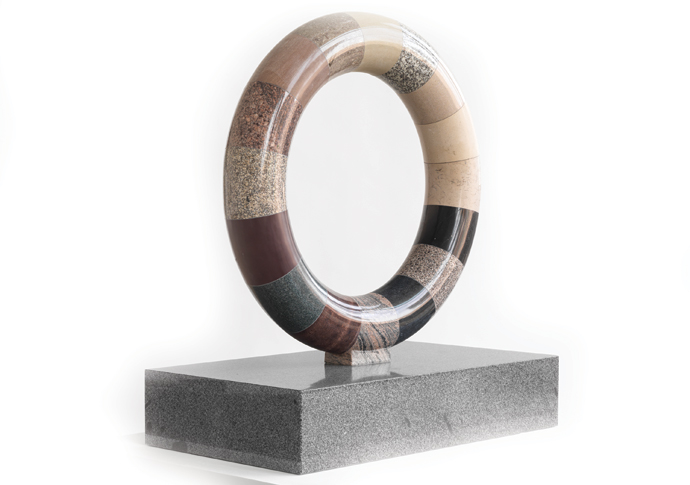Rock star
Journalist-turned-artist Angela Palmer’s material is as old as time ... rocks. Jane Clinton talked to her ahead of her exhibition at the Pangolin London Gallery
Thursday, 3rd August 2023 — By Jane Clinton

Stone me! Angela Palmer with her work, Tower of Time [Ewa McBride Photography]
IMAGINE touching a three-billion-year-old rock, then cutting into it. This is precisely what Highbury artist Angela Palmer did, the results of which are in her latest exhibition Deep Time: Uncovering Our Hidden Past.
The exhibition, at the Pangolin London Gallery, Kings Place, charts the history of our nation through the rocks that “lie unnoticed beneath our feet”. They are also the oldest materials on earth we are ever likely to encounter and will likely remain long after we’re gone, which is a sobering thought.
“Several of the sculptures in the exhibition feature Lewisian Gneiss rock from the Isle of Barra in the Outer Hebrides,” says Angela. “At three billion years old, it is one of the oldest rocks in the world – two-thirds the age of the planet. It is the oldest material you are ever likely to hold in your hand. Ever. That was very powerful for me, and of course you have immense respect and reverence for such a stone. I also acquired White Anorthosite rocks from the Isle of Harris in the Outer Hebrides, which are 2.5 billion years old. It is known as ‘moon rock’ as it is the same type of stone that the astronauts recovered from the Moon in the Apollo 15 mission in 1971.
“The rocks are immensely dense and hard, and very difficult to work; even the gentlest mark-making on their surface destroyed both my best chisels.
“But in a way that just underlines the point – their mass and durability are their essence, accreted over billions of years. I learned to respect that and I tried to work with the ancient material rather than imposing my will upon it.”
A highlight of the exhibition is Tower of Time, a 2.5 metre-high column featuring 16 rocks including the 2.5-billion-year-old White Anorthosite rock, which Angela bought from a disused quarry. The rocks come from Scotland, England, Wales and Northern Ireland.
Unsurprisingly, the project was several years in the making and proved a powerful learning experience for the artist.
“When I began this project I had no idea that our country originated near the South Pole, and that for billions of years Scotland and Northern Ireland enjoyed an entirely separate existence on a different continent to England and Wales,” she says. “It was only when the tectonic plates shifted that they collided and were physically united, just south of the Equator, 425 million years ago.”

Angela’s work, Torus of Time
She adds: “England and Scotland were ‘stitched’ together as a united country at roughly the same location as today’s Anglo-Scottish border.
“I hope observers will unlock their imaginations and allow themselves to be propelled to the South Pole where the most ancient of these rocks in this exhibition began their journey – a silent world with little oxygen, with no trees nor fish nor birds nor beasts.”
Indeed visitors to Deep Time can see, touch and interact with the rocks.
Angela is no stranger to ambitious, epic projects.
For the 2009 environmental installation, The Ghost Forest, 10 enormous tree stamps of commercially logged virgin forest were transported from Ghana to Trafalgar Square to highlight climate change and the “removal of the world’s lungs” through deforestation.
And during Covid, she re-created the virus particle at eight million times its size, entitled 2020: The Sphere that Changed the World which is in the Science Museum.
“Covid truly has changed the world and it demanded such an epic scale,” she says.
She admits she is attracted to the “urgent and critical issues of the day” and “what lies beneath the surface” which perhaps is no surprise given her years spent in journalism prior to becoming an artist.
Angela studied at Edinburgh College of Art, but dropped out to become a trainee at the Edinburgh Evening News. She went on to work at The Daily Telegraph; became diary editor of The Times; home news editor of The Observer; editor of The Observer Magazine; then editor of Elle.
She picked up the paintbrush again when as a married woman and bedridden for three months because of pregnancy complications she turned to art to keep her sane.
She began to paint from her hospital bed and went on to spend three years drawing and painting on the streets of Hong Kong.
On her return to the UK, she went to Ruskin School of Drawing and Fine Art, Oxford University; then did an MA at Royal College of Art and has worked as a professional artist ever since.
Her works are in the permanent collections of The Scottish National Portrait Gallery in Edinburgh, The Ashmolean Museum in Oxford, The Smithsonian Air and Space Museum in Washington, The Wellcome Trust in London, The Science Museum in London, among others.
Of Deep Time she says: “I hope visitors will experience wonder and awe in the presence of these ancient, mighty rocks. They speak of the eternal, in sharp contrast to our own ephemeral existence.
“Through seeing, touching and interacting with these rocks, which will be here billions of years after we have gone, I hope the exhibition will encourage a deeper appreciation and respect for our planet.”
• Deep Time: Uncovering Our Hidden Past is at the Pangolin London Gallery, Kings Place, York Way until September 16, www.pangolinlondon.com